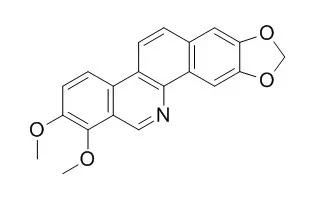| In vitro: |
| Planta Med. 2012 Jan;78(2):148-53. | | Antibacterial Benzofuran Neolignans and Benzophenanthridine Alkaloids from the Roots of Zanthoxylum capense[Pubmed: 22002848 ] |
METHODS AND RESULTS:
Two new 2-arylbenzofuran neolignans and a new benzophenanthridine alkaloid, together with six known benzophenanthridine alkaloids, namely, decarine, Norchelerythrine, dihydrochelerythrine, 6-acetonyldihydrochelerythrine, tridecanonchelerythrine, and 6-acetonyldihydronitidine, have been isolated from the MeOH extract of the roots of Zanthoxylum capense. Their structures were elucidated by means of spectroscopic techniques including 2D NMR experiments. All the isolated compounds were evaluated for their in vitro antibacterial activity against gram-positive and gram-negative bacteria.
CONCLUSIONS:
Some compounds showed significant inhibitory activity against Staphylococcus aureus ATCC 6538 with MIC values ranging from 12.5 to 50 μg/mL. | | Industrial Crops & Products, 2015 , 74 :407-411. | | Antifeedant activities of methanol extracts of four Zanthoxylum species and benzophenanthridines from stem bark of Zanthoxylum schinifolium against Tribolium castaneum[Reference: WebLink] |
METHODS AND RESULTS:
Antifeedant activities of the methanol extracts from Zanthoxylum bungeanum, Zanthoxylum schinifolium, Zanthoxylum armatum and Zanthoxylum dissitum were assessed on Tribolium castaneum adults. It was found that the methanol extract of stem bark of Z. schinifolium had the highest antifeedant activity at 41.12% (antifeedant index). Based on bioactivity-guided fractionation, six benzophenanthridines Norchelerythrine (1), decarine (2), 8-hydroxy-9-methoxy-2,3-(methylenedioxy) benzophenanthridine (3), 6-hydroxydihydrochelerythrine (4), 6-methoxy-7-hydroxydihydrochelerythrine (5) and oxychelerythrine (6) were isolated from the stem barks of Z. schinifolium. And their antifeeding activities were also evaluated against T. castaneum.
All of them exhibited strong antifeeding activity in a concentration-dependant manner with EC50 of 62.67, 66.97, 151.39, 96.72, 141.61 and 192.32 ppm, respectively.
CONCLUSIONS:
The six bioactive compounds from the stem bark of Z. schinifolium might be used as antifeedants against T. castaneum. |
|






 Cell. 2018 Jan 11;172(1-2):249-261.e12. doi: 10.1016/j.cell.2017.12.019.IF=36.216(2019)
Cell. 2018 Jan 11;172(1-2):249-261.e12. doi: 10.1016/j.cell.2017.12.019.IF=36.216(2019) Cell Metab. 2020 Mar 3;31(3):534-548.e5. doi: 10.1016/j.cmet.2020.01.002.IF=22.415(2019)
Cell Metab. 2020 Mar 3;31(3):534-548.e5. doi: 10.1016/j.cmet.2020.01.002.IF=22.415(2019) Mol Cell. 2017 Nov 16;68(4):673-685.e6. doi: 10.1016/j.molcel.2017.10.022.IF=14.548(2019)
Mol Cell. 2017 Nov 16;68(4):673-685.e6. doi: 10.1016/j.molcel.2017.10.022.IF=14.548(2019)